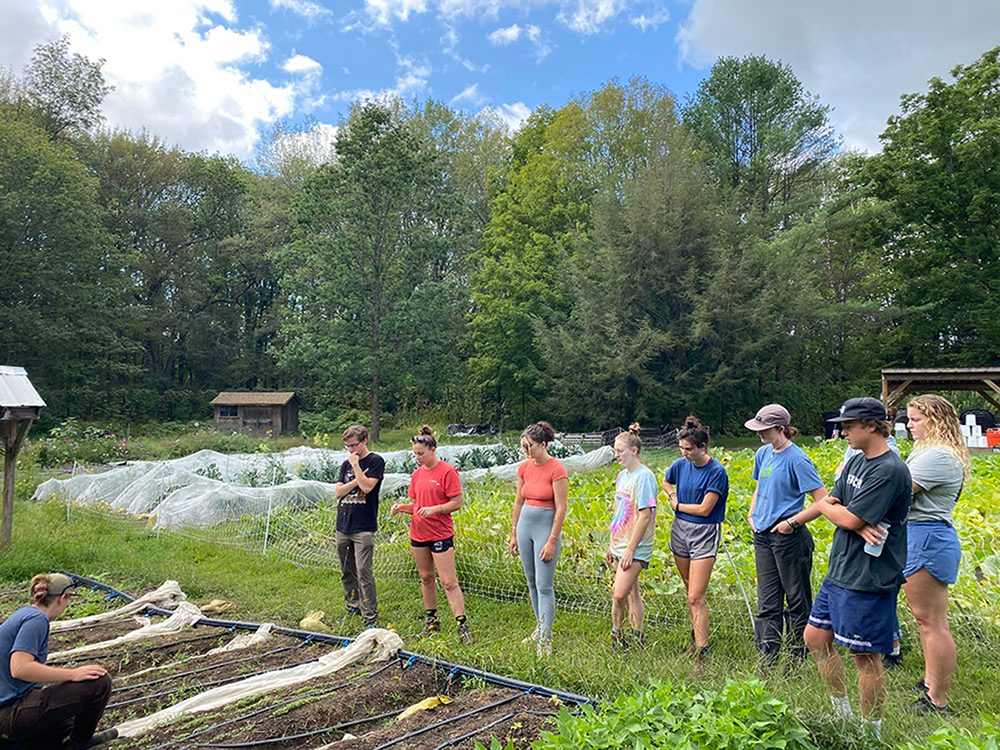Farm fall season ends with “Goodnight Farm”

Tess Curran | Co-Executive Editor | tcurran3@mail.smcvt.edu
As the colder season quickly approaches, the Farm at St. Michael’s College is winding down for winter. To prepare for this, volunteers are harvesting the remaining crops and planting the overwintering crops. Members of the Farm plan to come together on Oct. 28 for the annual “Goodnight Farm” event, to celebrate the end of the harvest as they share food and reflect on this seasons hard work.
“Goodnight Farm is a wonderful celebration of putting the farm “to bed” after cultivating it all summer and fall. It’s an awesome tradition that we have and is a great time to be with friends, ” said Carly Broome ’22, farm operations coordinator.
All are welcome to help close the farm and celebrate all the hard work students of our community have put in, said Portia Butrym ’23. Butrym joined the Farm this year as a student volunteer, and said her experience so far has been rewarding. “I find it a great change of pace compared to the rest of the work I do for school. The physical labor and projects that we do on the farm can feel challenging yet very rewarding,” she said.
The two-acre land is located behind Pomerleau Alumni Center, and was named an official part of campus in the 1980s. It was informally known as the “Hunger Gardens.” It has grown in size since then, and has become an integral part of the college community. The Farm, which is under the Garden Program, is run by Kristyn Achilich, director of the Center for the Environment and Environmental Studies & Science instructor. She works closely with Project Coordinator and Assistant Director, Christine Gall, along with work-study student employees and students in the Outdoor Classroom program. Students in the work-study program are hired as staff employees and learn agricultural practices for career preparation. The Outdoor Classroom program combines academics and volunteer work. Students in this program participate through different biology and environmental studies and science classes, which integrate the coursework with outdoor experience.
“I think getting to be outside and with plants is my favorite part about the farm, I love gardening and am a firm believer in biophilia so the farm feels very grounding even when the work is hard,” said Madeline Shanley ’23, a student volunteer through the Outdoor Classroom. As part of these classes, students must dedicate between three and 80 hours on the Farm each week, Shanley said.
She also explained that daily chores are run by students, in order to provide them working experience on the Farm. This includes harvesting, planting, organizing the Farm Stand and physical maintenance on-site.
Another way students can get involved is through the Outdoor Volunteer Effort (OVE), where students volunteer every Friday from 2-5 p.m. OVE volunteers can assist with the planting and harvesting of crops with the help of the staff. Students recently harvested a variety of fall crops including squash, pumpkins, celery and carrots. These crops will later be replaced with winter crops such as garlic, kale and spinach.
Crops grown on site end up either at the stand, Alliot, or most recently, the new Food pantry. The pantry, located in Alliot, receives fresh produce from the Farm for community members to take as desired.
“This is a huge step in increasing food security for students, which is something that the school often overlooks. Students are struggling to pay their tuition and housing bills, and with the rise in grocery prices, it can be extremely difficult to access food and fresh produce,” Butrym said. The goal is to support the new pantry by alleviating stress related to food insecurity and providing produce.
The Self-Serve Farm Stand runs Tuesdays and Fridays from 8a.m.-5p.m. in St. Edmunds 119. The stand takes produce grown on the Farm and makes it available for purchase. The in-person Farm stand has ended for the season. “All money raised from the produce goes directly back into seeds, materials, [and] any other farm necessities; therefore the prices can be kept lower in order to cater to students,” Shanley said. It is another way that the program directly connects with the community, as students cook with the crops that their fellow peers grew themselves.
Students join for a variety of reasons to enhance their educational studies or be exposed to a new occupation. “I joined because I’d focused my education on nature conservation and environment justice but realized I’d missed a large portion of the environmental community which is agriculture. I’ve been impacted by these classes at the farm in many ways but the first is thinking about eating in season, meaning only buying produce that is currently at its harvest,” Shanley said on her decision to become a volunteer.
If you are interested in participating, open volunteer hours are every Wednesday from 10 am to 12 pm until the end of the season and starts up again in the spring. The “Goodnight Farm” is open to all from 2-5 p.m., where volunteers assist in preparations for the winter by planting garlic, one of the overwintering crops, and celebrate the past season as a community. To get involved in other ways contact either Kristyn Achilich or email FarmProgram@smcvt.edu.


